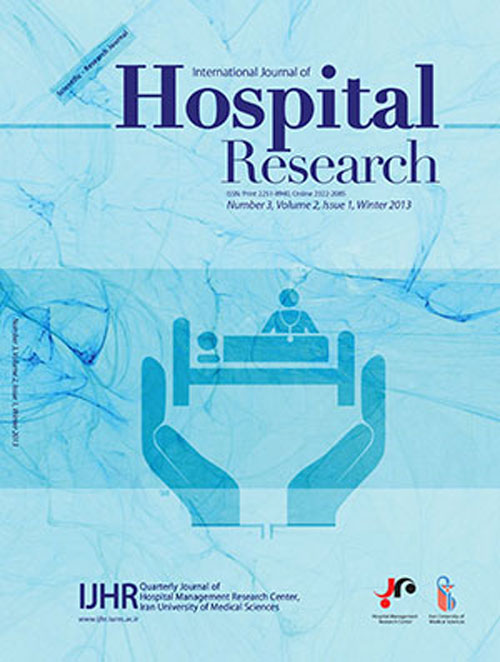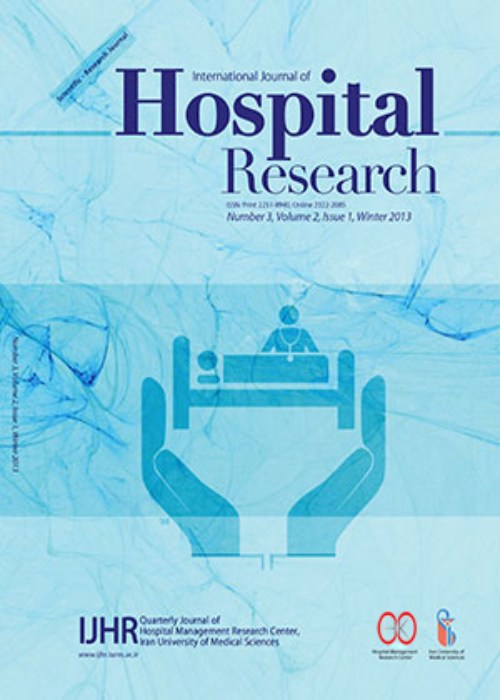فهرست مطالب

International Journal of Hospital Research
Volume:4 Issue: 2, Spring 2015
- تاریخ انتشار: 1394/02/10
- تعداد عناوین: 9
-
-
Page 47Background And ObjectivesInduced demand in healthcare is referred to as provision of unnecessary services or the patient by health services providers, while the patient is not aware of their unnecessity. Apart from being unethical, this practice can potentially disturb the supply and demand balance in the health market, pose financial load on the patient, thread the patient’s health by imposing possible side-effects, and lead to waste of the limited national health resources. This study, thus, was aimed at investigating the nature of the phenomenon in Iran, as perceived by the healthcare experts.MethodsA qualitative research design was adopted. Data was collected using semi-structure interview. Participations were selected by purposive sampling method. Thematic analysis was used for extracting and categorizing the major domains of induced demand.FindingsFour major categories of health services in which induced demand occurs were extracted from the interview data, including para-clinical services, medical services, surgical services, and pharmaceutical services. These health services domains account for nineteen specific health services with the potential of induced demand.ConclusionsThe study identified the health services domains in which induced demand frequently takes place. This information can help policy-makers to devise strategies for alleviating the problem.Keywords: Induced demand, Health care services, Health services providers
-
Page 55Background And ObjectivesPatient satisfaction is a key feature of quality improvement in modern health care systems. The focus of patient satisfaction studies has been on inpatient satisfaction measurement. As such, valid and reliable instruments for assessment of outpatient satisfaction are lacking in the field. This study aimed to develop and validate a brief scale to facilitate assessing outpatient satisfaction.MethodBased on existing literature and patient interviews, an initial pool of 20 items was generated. Item analysis and principal components analysis were carried out to evaluate the psychometric quality of items. Internal consistency of the instrument was evaluated by calculating Cronbach’s alpha for the whole scale and subscales.FindingsResults supported the appropriateness of all items. Moreover, principal components analysis using Varimax rotation yielded a four-factor solution. Reliability coefficients of subscales were within acceptable range. The existing brief 20-item scale was developed with four subscales of staff, physician care, clinial atmosphere, and overall satisfaction.ConclusionsTherefore, this brief scale may be served as a valid and reliable instrument in clinics, hospitals, and research settings.Keywords: Psychometrics, Patient satisfaction, Outpatients, Quality improvement, Scale development
-
Page 63Background And ObjectivesHigh performance research activity in the health domain is crucial to overcoming ever-growing health-related problems. Despite availability of data sources, only a limited number of researchers use these data to derive health-related information. Thus, the present study aimed at exploring the barriers to research promotion as perceived by the university health research experts.MethodsIn this cross-sectional study, 261 health experts from Kerman University of Medical Sciences were selected using census method. Data was collected using a questionnaire containing questions related to personal and organizational research barriers. Data were summarized using descriptive statistical methods.FindingsThe survey found lack of research advisors and sufficient facilities, lack of motivation, lack of expert librarians, limited budgets and poor cooperation of internal executive units were the as the most important organizational barriers. In addition, limited time and heavy work overload, limited knowledge of statistics and research method, and family responsibilities were identified as the most important personal barriers.ConclusionsThe wide range of barriers to research activities in health domain calls for comprehensive revision of current policies in the area of health research to boost the research activities. The diversity of the barriers identified highlights the need for a systems and holistic approach to health research promotion.Keywords: Health research, Health human resources, Policy, making
-
Page 71Background And ObjectivesData on patient complains can be used as a feedback to improve the quality of healthcare services. The aim of this study was to develop an indicator for reliable retrieval of statistical data on patient complaints.MethodsA triangulated study was conducted. A comprehensive literature review was done to identifying the relevant major themes. Two-rounds of Delphi sessions (8 experts were in attendance) and two panel meetings were held to refine and approve the themes. The obtained indicator was then used to collect patient complaint statistics from selected hospitals.FindingsA ten-item indicator of patient complaints was developed and used to survey patient complaints in Tabriz City (Northwestern Iran). Of the total 6958 complaints registered in Tabriz hospitals, 83.9% were made by inpatients and 82.5% were resolved in the hospitals. The rate of complaints was found to be 2.95 per 1000 referrals. Only 36% of hospitals had a written policy to use the complaints in quality improvement initiatives.ConclusionsApplication of the developed indicator revealed that the hospitals of Tabriz city are face with a relatively high rate of complaints when compared with the average rate in the literature. While the fact that majority of complaints are resolved in the hospital is promising, measure should be taken to encourage hospitals to use the complaints data in enhancing quality of services.Keywords: Complaint management, Patient satisfaction, Quality of Health Care, Hospital management
-
Page 77Background And ObjectivesVisit length is a crucial aspect of patient-physician relationship that its inadequacy can negatively influence the treatment efficiency. Studies on visit length and the factors influencing it are limited in developing countries. Thus, the objective of this study was to survey this variable at provincial level, and provide data on factors affecting it.MethodsA sample of 428 patients who referred to the outpatient clinics of the general hospitals of Qazvin Province (Northern Iran) was randomly selected and surveyed. Data was collected by a researcher-made checklist and summarized using descriptive statistical methods. Kruskal-Wallis and Mann-Withney tests were used to examine the significance of the differences. The relationship between variables was explored by multivariate regression analysis.FindingsThe average visit time was found to be 4.67 min, which is significantly lower than the minimum average of 15 min approved by the Iranian Ministry of Health and Medical Educations (MOHME). Pediatric physicians took significantly longer time to visit the patients, followed by general surgery, obstetrics and gynecology, internal physicians. The visit time of the male patients (5.09 min) was significantly longer than that of females (4.5 min). Multivariate linear regression identified negative relationship between visit length and patient visit frequency, experience of physician, and academic membership.ConclusionsThe study shows the overwhelming shorter length of patient visit in a number of Iranian hospitals. The large difference in the current visit length and the domestically approved standard calls for urgent conduction of large-scale studies to gain insight into the nation-wide magnitude of the problem. Identification of factors contributing to short visit length in this study set a starting point to explore the issue on a broader scale and aid policy-maker to devise solutions.Keywords: Visit length, Patient, Physician, Patient satisfaction, Hospital, Treatment efficiency
-
Page 83Background And ObjectivesInformal payment in the health settings is a significant challenge facing the health system, with consequences such as inequity in access to healthcare services, distrust to health care system, and dissatisfied customers. Detailed identification of the nature of the problem is perquisite to developing relevant overcoming strategies. Given that, this study aimed at providing information on the frequency of informal payment in teaching hospitals and exploring the factors influencing this phenomenon.MethodsA sample of 201 patients was selected from Surgical, Internal, and Emergency departments and ICU and CCU of teaching hospitals of Shiraz University of Medical Sciences to participate in the study. A researcher-designed questionnaire was used as the study tool. Chi-square test was applied for examining the significance of the differences.FindingsOf the total patients surveyed, 41 (20%) experienced informal payment. Cash offering was the most frequent form of payment (39%). More than half of the payments have been done in Emergency department (51.2 %) followed by Internal (17.1 %) and Surgery (12.2 %) departments. The informal payment was found to be significantly more prevalent among the primarily insured patients (P < 0.05). No significant relationship between demographic variables and informal payment frequency was identified.ConclusionsThis study identified the Emergency department as the area of focus for controlling informal patient in health care system. The finding that insured patients are more exposed to informal payment request encourages further studies to identify the causative factors.Keywords: Informal payment, Health setting, Health care system, Health care services, Teaching hospital
-
Page 89Education and information delivery is an integral part of an effective strategy to control the prevalence of obesity and diabetes. Nutrition and dietetic portals provide integrated access to a wide range of information resources for nutritionists, physicians and the public due. The nutrition and dietetic portals in selected countries was reviewed to gain insight into the essential elements of such portals. The nutrition and dietetic portals were found to be common in presenting annual statistics, nutrition news, and calendar of events, providing information on job opportunities, different diets, strategies and policies, professional standards and rules, providing access to nutrition guidelines and manuals, and introducing educational and research facilities. The data on types of information and services provided by the nutrition and dietetic portals can be used in developing novel portals of the kind in other countries.Keywords: Nutrition, Diet, Portal, Health Information Technology
-
Page 95Reducing wastes in the healthcare processes is crucial for developing a high performance health system. Adopted from the Toyota Production System (TPS), the Lean concept has emerged in recent years as a way of introducing innovative ideas to improve industrial processes. In the context of health care, Lean is considered as a continuous improvement model, which provides healthcare organization to identify and remove the wasteful activities. Implementation of Lean concept can benefit from use of new technologies that facilitate management of patients, human resources, and inventories. RIDF is one of these technologies, which by its traceability and real-time provision of information can help removing non-value added activities in healthcare processes. The purpose of this paper was to systematically explore how healthcare organizations can take the advantages of RFID to optimize their process and create value added towards ultimately becoming Lean. We categorized the major advantages of RFID in the context of health care and the Lean scopes that can benefit from RFID and discussed the relationship between the two concepts.Keywords: Lean, RFID, Healthcare, Waste reduction, Hospital management, Health care process, Health care organization, Health care system
-
Page 103There are two major methods in predincing the pattern of share value in the stock market: fundamental analysis and technical analysis. I this study we developed a novel model for fundamental analysis of share price and validated it by predicting the behavior of phrama share price in Tehran stock market. The efficiency of the fundamental method was compared with that of indicator-based technical analysis and the implications for facilitating investment was discussed.Keywords: Stock market, Fundamental analysis, Technical analysis, Pharmaceutical companies, Investment, Efficiency


